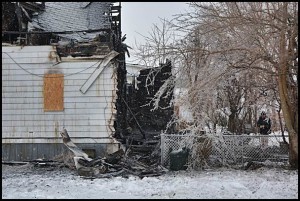A new model in firefighting

Hamtramck has a new mutual aid agreement with Highland Park and Detroit which ensures additional help when fires occur.
By Charles Sercombe
Back in October Hamtramck firefighters entered a deal that would guarantee more work for them.
The department agreed to expand its already existing mutual aid plan with Detroit and Highland Park. The plan called for Hamtramck to continue to respond to Highland Park when needed, but expanded the call for help in Detroit to fires within a one-mile radius from Hamtramck.
Those two cities also agreed to help out with any fire that occurs in Hamtramck. All cities were required to send a crew and a fire truck to assist.
That means if Hamtramck has a fire, a total of 15 firefighters and two extra trucks would be on hand.
With a new labor contract in place for Hamtramck firefighters there are no more than six on duty at one time, and if any call in sick or take the day off, the department is not required to call in replacements.
In other words there is no longer a minimum staffing requirement.
This groundbreaking contract is saving overtime costs for the city, lowering the amount from $300,000 a year to $50,000.
At the time of the new mutual aid agreement, there was concern whether Hamtramck would get the raw end of the deal, especially considering the poor condition of Highland Park’s department.
So how has the new plan worked out?
Not as bad as you would think, but Hamtramck firefighters are definitely busier than they had been.
Hamtramck Fire Chief Paul Wilk has nothing but praise for how things have worked out.
“We’re getting a lot in return,” he said. “We get security that they are coming.”
He said prior to this agreement, Hamtramck would have no more than seven to eight firefighters to respond to a fire – no matter its size. Sure, Wilk could have called for help from Detroit and called in firefighters for overtime, but that meant waiting for them to respond.
It took a few months for this new agreement to swing into action. Wilk said the departments had to familiarize themselves with equipment and procedures. A new dispatch service had to be worked out, too.
“There was a lot of training that had to happen,” Wilk said.
As it has worked out, Hamtramck has not had to respond to a Highland Park call. He said Detroit has taken on that workload.
But Hamtramck has responded more to Detroit than vice versa. The program didn’t start until January of this year. Here are the monthly breakdowns for the exchange between Hamtramck and Detroit:
In January, Detroit helped Hamtramck in three fires and 10 other runs (which included alarms and false alarms). Hamtramck assisted in five Detroit fires (and five other runs).
In February, Detroit came to Hamtramck five times, and Hamtramck responded to 13 Detroit fires (and six other runs).
In March, Hamtramck runs to Detroit spiked up to 39, and Detroit came to Hamtramck four times.
Wilk concedes that this expanded mutual aid agreement means more wear and tear on equipment. But the arrangement will also lead to an increased likelihood of winning grants to replace trucks and other equipment.
For firefighters, it means honing their skills – which is something that could come at a price, he said.
“You’re still risking your life,” Wilk said.
Still that risk is worth it, he says, considering what the city gets in return – especially if there is a major fire.
Wilk says Hamtramck gets this backup: “Two fire engines, one ladder truck, one squad, and a battalion chief, and 15 people. The goal for the response is to have a short response time to an emergency, and have enough people, and resources (equipment) to safely, effectively, and efficiently perform our jobs.”
No matter how many firefighters he has on hand, he knows Detroit and Highland Park have Hamtramck’s back.
So far, the new mutual aid arrangement has been a work in progress. Two years ago, Wilk said, he never would have predicted this amount of cooperation.
“We had very little communication with Detroit,” Wilk said.
In fact, there were some in the Detroit command, he said, who sharply questioned Wilk’s motives.
Wilk had to point no further than to Gov. Snyder who demanded from the onset of his first term in office some five years ago that communities begin to share services.
This mutual aid model fits in with that mandate and preserves Hamtramck’s independent fire department.
It’s not been an easy process, though. Wilk says it takes “weekly meetings, constant monitoring of the responses, the input of the firefighters and dispatchers.”
This, he said, “is a sign of a management team that is dedicated to the cause.”

